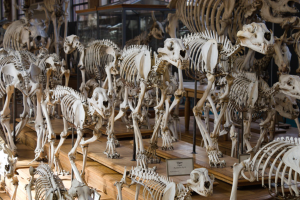Examining the anatomy of an organism opens up a whole world of exploration into the function of its body, its evolution, and how it interacts with the biotic and abiotic elements in its environment. On the cusp of new advances in technology that have furthered this exploration, the editors at Communications Biology have gathered a Collection of our exciting research in organismal anatomy to highlight the possibilities of this field yet to come.
Data exploration is the initial step of any new scientific analysis. Getting a “feel” for your data can inform and direct more formalised statistical approaches, or encourage future experiments. When considering organismal biology, the anatomy of the animal, plant or microbe is the data, and exploration happens through observations.
For hundreds of years, biologists have been using anatomical insight to learn more about the world surrounding us. Some of the most influential scientific discoveries of the past are based on observing organism anatomy--the basis for the evolution by natural selection popularised by Charles Darwin1 (with due credit to Alfred Russel Wallace), Owen’s naming of Dinosauria2, or Mendel’s demonstration of genetic inheritance. Without detailed, insightful observations of the world around them, these discoveries could not be made.
For hundreds of years, biologists have been using anatomical insight to learn more about the world surrounding us. Some of the most influential scientific discoveries of the past are based on observing organism anatomy.
Whilst the most immediate observations might occur on a macroscopic level, such as examining a fossil or living creature in its natural habitat, anatomical observations are not limited to this wide lens. Using modern advances in technology, we can look beyond the surface level structures of an organism, delve deeper into its anatomy, and make inferences about the evolution of its function. Computed tomography, scanning electron microscopy or synchrotron scanning are becoming commonplace methods in anatomical research in observing organisms from both modern and deep time. Combinations of these methods are enabling researchers to ask questions that were previously unanswerable, such as the fine details of venom delivery in snakes3, or the importance of fully understanding anatomical constraint before inferring function in fossil vertebrates4.
Communications Biology appreciates the value of anatomical research in the modern age, and has created a collection of some of our published manuscripts highlighting anatomical structures and the inferences they yield. Our published papers span palaeontological studies enabling phylogenetic and functional inference, studies of extant systems with significant genetic or ecological context, and structural analyses of microscopic details focussing on the biological function of organisms, plus many more assembled together by our editors in our Anatomy Collection. We welcome further submissions featuring anatomical research across all species, especially for those highlighting functional or ecological analyses.

References
Darwin, C & Murray, J. On the Origin of Species by Means of Natural Selection, or, The Preservation of Favoured Races in the Struggle for Life (J. Murray, 1859).
Owen, R. Report on British fossil reptiles. Part II. Rep. British Assoc. Adv. Sci. 11, 60–204 (1842).
Cleuren, S. G. C., Parker, W. M. G., Richards, H. L., Hocking, D. P. & Evans, A. R. Sharp and fully loaded: 3D tissue reconstruction reveals how snake fangs stay deadly during fang replacement. J. Anat. 00, 1–10 (2021).
Manafzadeh, A. R. & Gatesy, S. M. Paleobiological reconstructions of articular function require all six degrees of freedom. J. Anat. 00, 1–9 (2021).
Rights and permissions
Open Access This article is licensed under a Creative Commons Attribution 4.0 International License, which permits use, sharing, adaptation, distribution and reproduction in any medium or format, as long as you give appropriate credit to the original author(s) and the source, provide a link to the Creative Commons license, and indicate if changes were made. The images or other third party material in this article are included in the article’s Creative Commons license, unless indicated otherwise in a credit line to the material. If material is not included in the article’s Creative Commons license and your intended use is not permitted by statutory regulation or exceeds the permitted use, you will need to obtain permission directly from the copyright holder. To view a copy of this license, visit http://creativecommons.org/licenses/by/4.0/.
About this article
Cite this article
Anatomy in the animal kingdom. Commun Biol 4, 1082 (2021). https://doi.org/10.1038/s42003-021-02613-0
Published:
DOI: https://doi.org/10.1038/s42003-021-02613-0
